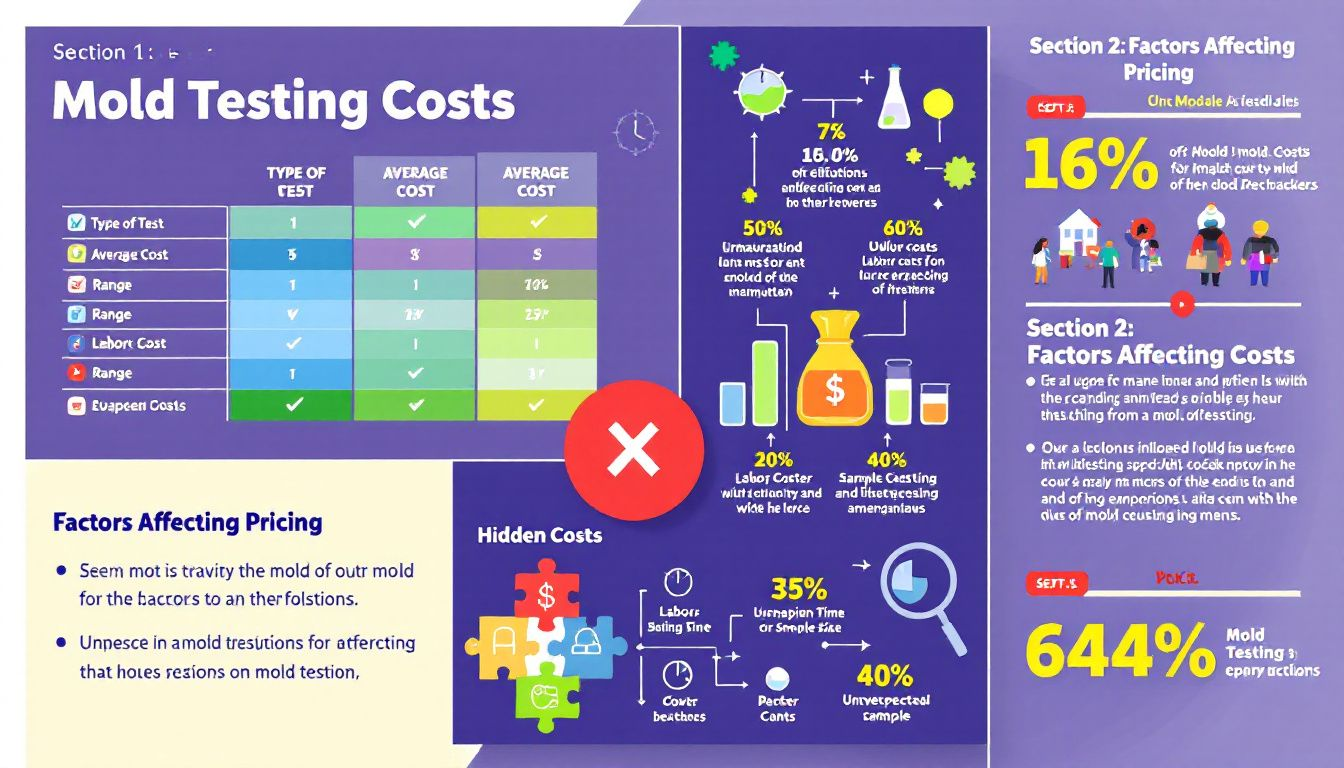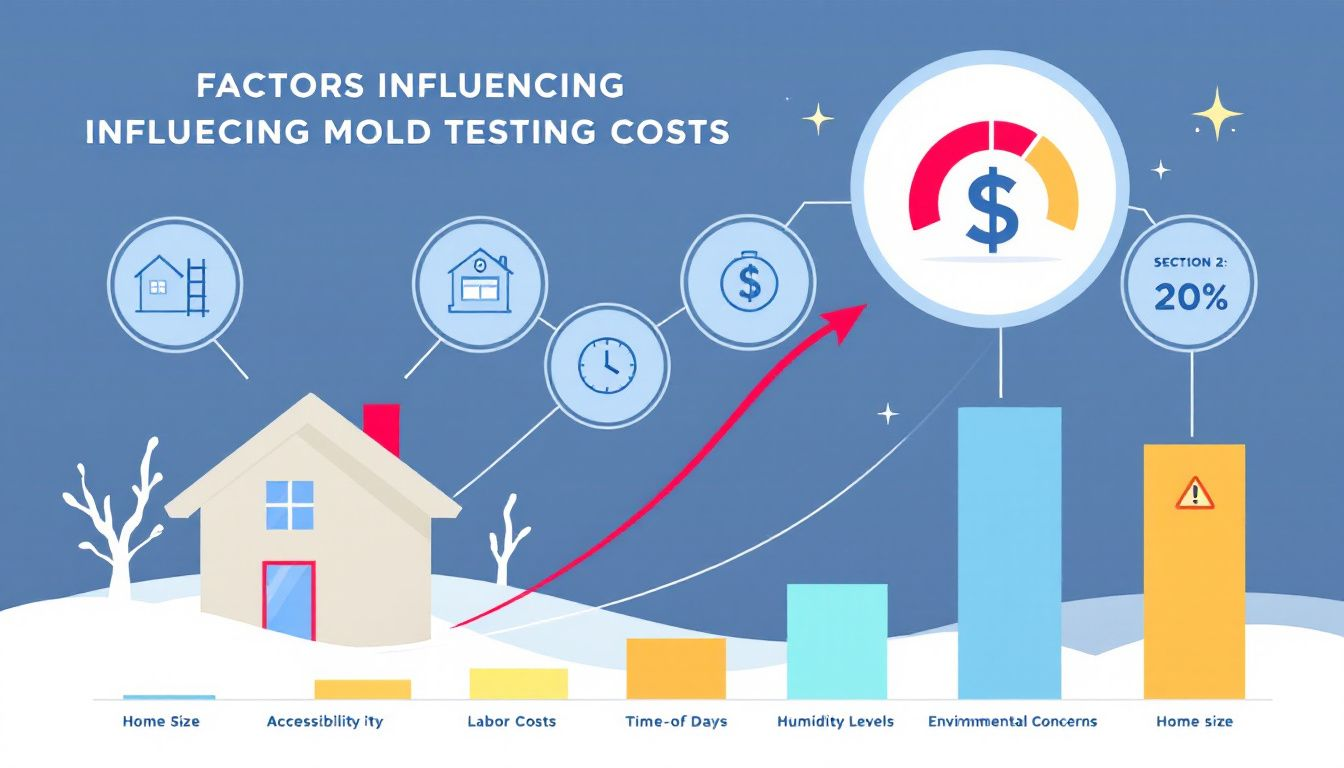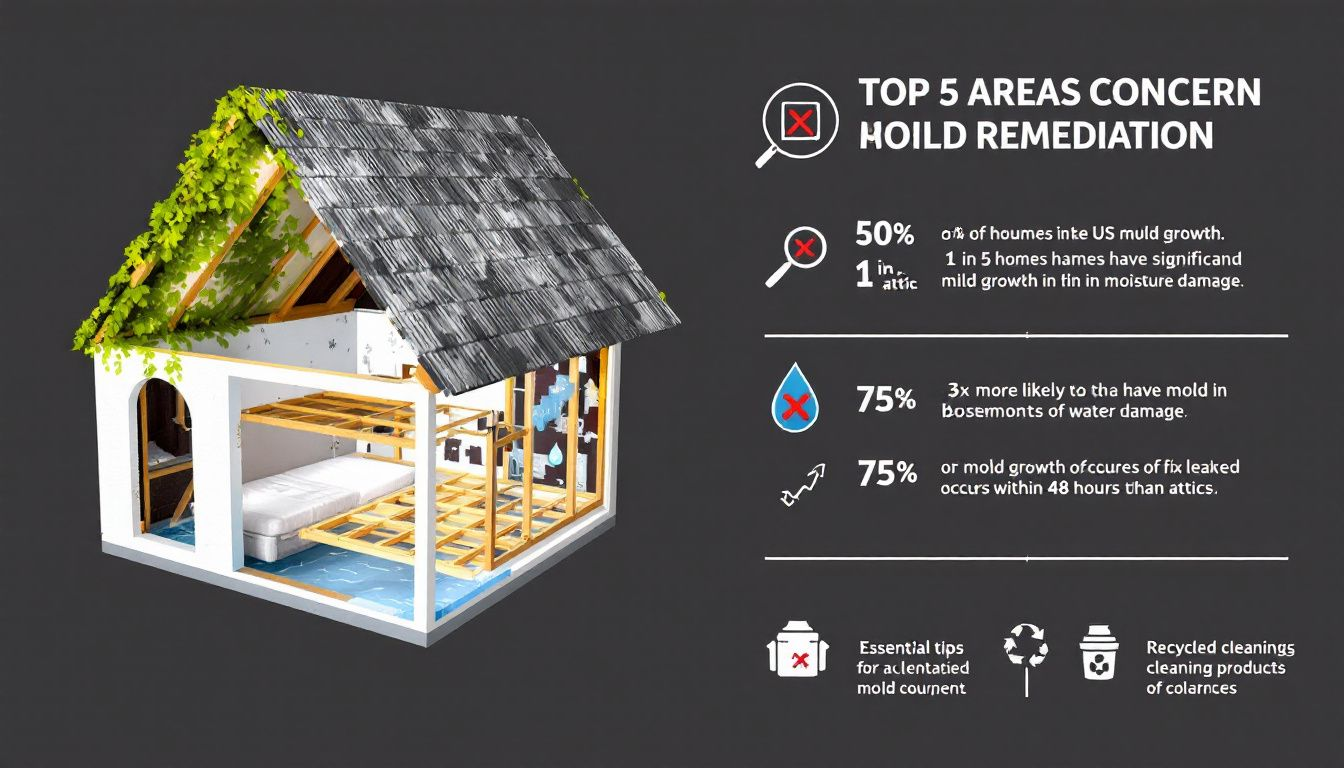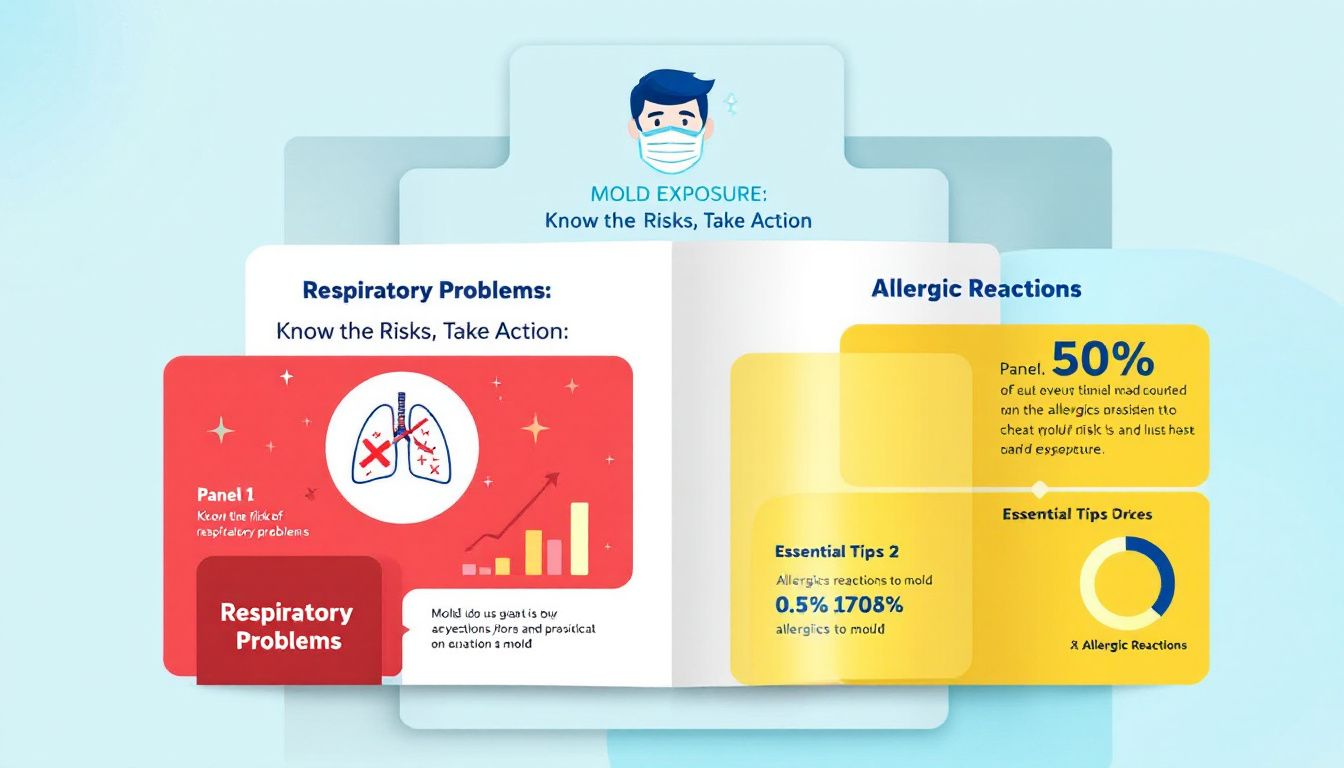Mold Testing

,
How Much Does Mold Testing and Removal Cost? | 2025 Guide
Worried about mold testing and removal cost? Testing costs range from $200 to $1,025, and removal can cost anywhere from $500 to $30,000. This guide will help you understand these costs and the factors that affect them.
Key Takeaways
Mold testing costs average around $656, with inspection and air sampling typically ranging from $200 to $1,025 and $250 to $350 respectively.
Mold remediation costs vary based on severity and location, averaging between $1,100 and $3,400 for smaller projects, whereas full-home remediation can reach $30,000.
Preventive measures, such as controlling moisture levels and fixing leaks promptly, are crucial to avoiding mold growth and potential health risks associated with mold exposure.
Overview of Mold Testing Costs

Mold testing is the initial step in identifying potential mold issues in your home. On average, homeowners should budget around $656 for a mold inspection, with costs typically ranging from $300 to $1,025. Mold testing itself usually falls between $200 and $350, but extensive testing can exceed $700 depending on specific circumstances.
This process often includes on-location mold test and lab analysis of samples to identify the presence and type of mold spores in your home.
Air Sampling Costs
Air sampling is a common method used during mold inspections to detect airborne mold spores. The cost for an air test generally ranges from $250 to $350. Although air sampling can be about three times more expensive than surface sampling, it offers a comprehensive analysis of the mold situation in your home.
For extensive testing, such as sampling an entire area with 50 samples, costs can reach up to $50,000.
Surface Sampling Costs
Surface sampling involves collecting samples from various surfaces where mold is visible or suspected. This method typically costs between $200 and $300, with the average cost being about $50 per specimen.
Surface samples are particularly useful for identifying visible mold and assessing the extent of mold infestation on specific surfaces.
Lab Analysis Fees
After collecting mold samples, they are sent to a laboratory. There, they undergo analysis. Lab testing fees can range from $50 to $150, depending on the type of analysis required. This step provides detailed information on the types of mold present and their concentrations, aiding in the development of an effective remediation plan.
Factors Influencing Mold Testing Costs

The cost of mold testing is influenced by several factors, including the size and complexity of your home, the accessibility of the mold, and the number and type of samples required. Being aware of these factors can help you better anticipate mold testing expenses and prepare for potential costs.
Home Size and Complexity
Larger homes require more time and samples during mold inspections, which can significantly increase the overall cost. Complex structures with multiple levels or intricate designs require more thorough inspections, which can lead to higher costs.
The overall costs of mold inspection can rise due to these factors.
Accessibility of Mold
The accessibility of mold is another critical factor that influences testing costs. If mold is located in hard-to-reach areas such as behind walls, between tiles and drywall, or inside crawl spaces, the inspection process becomes more time-consuming and expensive.
Inaccessible areas may require extensive checking, which can take up to six hours and further increase costs.
Number and Type of Samples
The number and type of samples collected during a mold inspection can also affect the overall cost. Some inspection companies require a minimum number of samples to ensure thorough assessment. Different sampling methods, such as swab testing, air cell testing, and specialty HVAC testing, come with varying costs, typically around $50 per specimen for surface samples.
Specialized tests for toxic molds or other specific types of mold can add to the expense.
Mold Removal Cost Breakdown

Mold removal costs can vary widely based on the extent of the infestation and affected areas. On average, mold remediation costs range from $1,100 to $3,400, with the national average around $3,500. These costs are influenced by factors such as the severity of the mold problem, the materials affected, and the chosen mold remediation cost techniques.
Small-Scale Remediation
For small-scale mold remediation projects, costs typically range from $500 to $1,500. The mold inspection cost for a black mold inspection can be between $600 to $800, while inspections for other types of mold like Fusarium and Penicillium range from $500 to $800. Additionally, mold inspection costs can vary based on the specific circumstances of the project.
Taking more samples during inspection can increase costs.
Full-Home Mold Remediation
Full-home mold remediation is a comprehensive process that can cost between $10,000 and $30,000 depending on the extent of mold damage. The size of the building, the amount of mold, and the type of mold are significant factors influencing these costs.
Black mold, for example, is more expensive to remove than green mold.
Additional Repair Costs
In addition to mold remediation, homeowners should consider the costs of repairing mold-damaged areas. Repairing drywall can cost between $300 and $825, while replacing carpeting can cost around $980. Plumbing repairs related to mold remediation can range from $40 to $200 per hour, and restoring the home to its original state can add to the overall expense.
Mold Remediation in Specific Areas

The cost of mold remediation can vary significantly depending on the specific area of the home affected. Attics, basements, and bathrooms are common areas where mold growth occurs, each presenting unique challenges and costs.
Attic Mold Remediation
Attic mold remediation typically costs between $1,000 and $3,000, but can go up to $4,000 depending on the extent of the mold issue. Additional costs may arise from repairing roof leaks, which can range from $350 to $1,250.
Large or undetected roof leaks can significantly increase remediation costs.
Basement Mold Remediation
Basement mold remediation often costs between $3,500 and $5,000 due to the dark, damp conditions that favor mold growth. This process is essential for maintaining a healthy home environment, especially in areas with high humidity and poor ventilation.
Bathroom Mold Remediation
Bathroom mold remediation costs typically range from $500 to $1,000. However, costs can substantially increase if mold is hidden behind the sink, tub, or walls, requiring more extensive removal and repair efforts.
Professional vs. DIY Mold Remediation
When dealing with the mold remediation process, homeowners must decide between hiring a professional mold remediation company or attempting DIY methods.
While professional services are more expensive, they offer specialized equipment and expertise that can ensure thorough and effective remediation.
Benefits of Hiring Professionals
Hiring professionals for mold remediation brings several benefits. Professionals use specialized tools like air quality meters, UV lights, and moisture meters for effective mold detection. Their methods, including steam cleaning, scrubbing, air sanitizers, and vacuum cleaners, ensure thorough remediation.
Their expertise reduces the risk of mold spreading and recurring, offering peace of mind to homeowners.
DIY Mold Remediation Costs
DIY mold removal can be significantly cheaper, often costing between $50 to $300. However, the effectiveness and thoroughness of DIY methods may lack compared to professional services. Additionally, safety gear, such as masks and gloves, adds to the cost of DIY mold remediation.
Preventing Mold Growth
Preventing mold growth is crucial for maintaining a healthy home environment. Key strategies include controlling moisture levels, conducting regular inspections, and fixing leaks promptly.
Controlling Moisture Levels
Maintaining low moisture levels is key to preventing mold growth, which is likely to occur when humidity levels exceed 50%. Installing a powerful dehumidifier can help maintain indoor humidity levels below 60%, significantly hindering mold development.
Regular Inspections
Regular inspections are vital for detecting mold issues early before they become costly and difficult to manage. Controlling moisture levels through the use of dehumidifiers and proper ventilation is also crucial in preventing mold growth.
Promptly fixing leaks can significantly reduce the risk of mold growth in homes.
Fixing Leaks Promptly
Addressing leaks immediately is crucial to prevent mold growth, as any excess moisture can lead to significant mold issues. The cost to seal a foundation to prevent basement mold ranges from $2,250 to $7,100, making it a significant investment for homeowners.
Using exhaust fans during cooking and bathing helps mitigate moisture accumulation, reducing the risk of mold growth.
Health Risks Associated with Mold

Exposure to toxic mold can pose serious health risks, particularly for individuals with allergies, asthma, or weakened immune systems.
Understanding these risks is vital for taking appropriate measures for mold remediation and prevention.
Respiratory Problems
Black mold, scientifically known as Stachybotrys Chartarum, can lead to various health issues, including respiratory problems, infections, and neurological issues. Chronic coughing, sneezing, and eye irritation are common symptoms of black mold exposure. Fatigue and headaches can also occur.
Immediate removal of black mold is necessary to prevent further health complications.
Allergic Reactions
Cladosporium, commonly found in basements and HVAC systems, can exacerbate allergy symptoms in susceptible individuals. Mold-induced allergies can trigger a range of allergic reactions, including sneezing, nasal congestion, and skin rashes.
Long-Term Health Effects
Prolonged exposure to mold can lead to serious health issues such as persistent lung inflammation, which may result in permanent lung damage. Mitigating these risks through effective mold remediation is crucial for long-term health.
How to Choose a Professional Mold Inspector
Selecting a professional mold inspector is crucial for ensuring proper mold evaluation and remediation. Several factors, including certification, customer reviews, and inspection process transparency, should be considered by homeowners.
Certification and Licensing
Certification ensures mold inspectors are trained in industry standards and practices. Reliable certifications, such as from the Indoor Air Quality Association (IAQA) and the National Association of Mold Professionals (NAMP), indicate a high level of expertise and professionalism.
Some states may require independent licensing for mold inspectors, separate from the companies they work for. Ensuring your inspector has these credentials can provide peace of mind and assurance of quality service.
Customer Reviews and References
Customer testimonials and reviews are invaluable resources when choosing a professional mold inspector. They can reveal significant insights into the quality of service provided by the inspectors. Requesting references from previous clients can help gauge a mold inspector’s reliability and effectiveness.
Word-of-mouth recommendations from friends, family, or trusted professionals like home inspectors or realtors can be a reliable way to find qualified mold inspectors.
Inspection Process Transparency
Transparency in the inspection process is crucial for ensuring homeowners feel secure about the findings and recommendations. Discussing and scheduling an appointment over the phone can help ensure you are comfortable with the mold inspector.
A reputable inspector will provide detailed information about their inspection process and offer a comprehensive report of their findings and suggested actions. This transparency helps build trust and ensures you are well-informed about the condition of your home.
Summary
Understanding the costs and processes involved in mold testing and removal is essential for protecting your home and health. From the initial testing costs to the factors influencing these expenses and the detailed breakdown of remediation costs, this guide has provided a comprehensive overview. Whether you choose professional services or a DIY approach, taking preventive measures and addressing mold issues promptly can save you significant costs and health risks in the long run. Remember, investing in proper mold remediation is investing in the well-being of your home and family.
Frequently Asked Questions
How much does a typical mold inspection cost?
A typical mold inspection costs around $656, generally ranging between $300 and $1,025. It is essential to budget accordingly when considering this expense.
What factors influence the cost of mold testing?
The cost of mold testing is influenced by the size and complexity of the property, the accessibility of mold, and the quantity and type of samples needed. Understanding these factors can help you anticipate the expenses involved.
What is the cost range for small-scale mold remediation?
Small-scale mold remediation typically costs between $500 and $1,500. This range reflects the varying factors involved in the remediation process.
Are there health risks associated with mold exposure?
Indeed, exposure to mold poses health risks that include respiratory issues, allergic reactions, and potential long-term effects like chronic lung inflammation. It is advisable to address mold problems promptly to mitigate these risks.
How do I choose a professional mold inspector?
Choose a professional mold inspector by verifying their certification and licensing, checking customer reviews and references, and ensuring they maintain transparency throughout the inspection process. This approach will help you select a qualified and trustworthy inspector.
Latest news

Bio Cleaning Services
Read More
Nosy neighbors peeking? T.A.C.T. North Atlanta offers discreet biohazard remediation for rodent infestations, mold, hoarding, and more. Unmarked vehicles, quiet experts, full privacy—24/7 service at 470-781-4775.
Read More
